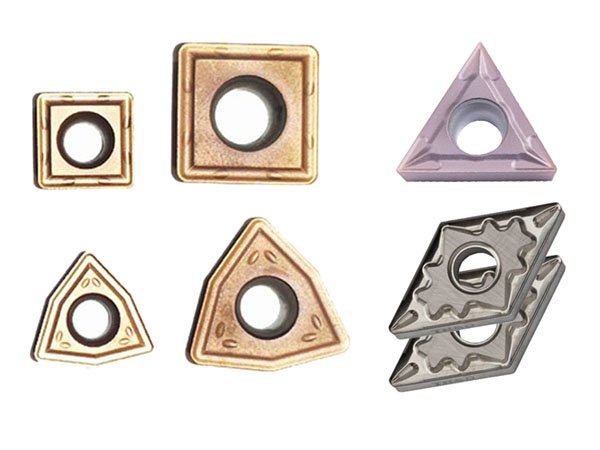Indexable U-Drill Insert Shape Selection Guide: From Fundamentals to Practical Applications
For professionals in metalworking, choosing the right indexable U-drill insert is like selecting the perfect tool—it’s not just about the specifications, but also about the actual machining scenario. This article explains the features of four common insert shapes—square, convex triangle, rhombic, and hexagonal—in a clear and practical way, and includes real-world machining comparisons.
Basic Shape Characteristics Comparison
| Insert Shape | Number of Cutting Edges | Typical Diameter Range | Recommended Materials | Cost per Edge (Reference) |
|---|
| Square | 4 edges | 12–25 mm | Cast iron, carbon steel | ¥80–120 |
| Convex Triangle | 3 edges | 8–16 mm | Aluminum alloy, cast bronze | ¥150–200 |
| Rhombic | 2 edges | 6–12 mm | Stainless steel, titanium alloy | ¥220–300 |
| Hexagonal | 6 edges | 18–30 mm | Tool steel, alloy steel | ¥180–250 |
The Physics Behind Insert Geometry
1. Edge Curvature and Cutting Force Distribution
2. Chipbreaker Topology Optimization
| Shape Type | Chipbreaker Helix Angle | Chip Thickness Coefficient | Critical Chip Breaking Speed |
|---|
| Square | 15° | 0.8 | 120 m/min |
| Convex Triangle | 22° | 1.2 | 80 m/min |
| Rhombic | 28° | 0.6 | 150 m/min |
| Hexagonal | 18° | 1.0 | 200 m/min |
Note: Based on AISI 1045 steel, 2 mm depth of cut
Material Science and Coating Compatibility (New Section)
1. Insert Substrate Material Matrix
| Insert Shape | Recommended Substrate | Grain Size (μm) | Flexural Strength (GPa) | Thermal Conductivity (W/m•K) |
|---|
| Square | YT15 | 0.8 | 3.2 | 85 |
| Convex Triangle | YG8 | 1.2 | 2.8 | 95 |
| Rhombic | YW3 | 0.5 | 3.8 | 78 |
| Hexagonal | YS25 | 0.6 | 3.5 | 82 |
2. Coating Technology Breakthroughs
- Hexagonal Inserts:
- Applied AlTiN/Si₃N₄ nano multilayer coating (4 μm total thickness)
- Red hardness increased to 1200°C (vs. 950°C in standard coatings)
- When machining H13 die steel, crater wear reduced by 60%
- Rhombic Inserts:
- Gradient coating tech (TiCN → Al₂O₃ → TiN)
- Coefficient of friction reduced from 0.7 to 0.45
- Tool life extended by 3.2 times when cutting Inconel 718
Practical Application Scenarios
1. Square Insert – Cost-Effective Choice
- Feature: Four cutting edges can be indexed for highest cost-efficiency
- Case: Automotive plant machining HT250 cast iron brake disks
- Insert: WNMG080408
- Parameters: 800 rpm, 0.2 mm/rev feed
- Result: 4 hours tool life per edge, 37% reduction in unit cost
2. – Expert in Irregular Profiles
- Special Design: Curved edge reduces stress concentration
- Use Case: Machining aluminum housings with casting flash
- Compared to square inserts:
- Edge chipping rate reduced from 25% to 6%
- Surface finish improved by 2 levels
- Note: Requires high-pressure coolant (≥70 bar)
3. Rhombic Insert – Precision Machining Specialist
- Advantages:
- Tip angle 55° vs. 80° in standard inserts
- Cutting resistance reduced by 40%
- Suitable for deep holes (depth > 5×D)
- Test Case: Machining 304 stainless steel pipe fittings
- Insert: CCMT09T304
- Performance: 8 hours continuous machining with no wear
- Bore deviation < 0.02 mm
4. Hexagonal Insert – Heavy Cutting Champion
- Innovation Highlights:
- Each insert usable 6 times
- Reduces tool change time by 50% compared to square inserts
- Case Study: Wind power flange manufacturer
- Material: 42CrMo4 alloy steel
- Cutting Parameters: Vc = 180 m/min, ap = 6 mm
- Material removal rate: Up to 480 cm³/min
Selection Decision Tree
- By Material Hardness:
- HRC < 30 → Prefer square/hexagonal inserts
- HRC > 45 → Must use rhombic inserts
- By Machining Depth:
- Shallow holes (<3D): Any shape
- Deep holes (>5D): Rhombic > Convex triangle
- By Cost Control:
- Mass production: Hexagonal > Square
- Small batch: Rhombic > Convex triangle
Maintenance Tips
- Square Insert: Rotate 30° every 2 hours of use
- Rhombic Insert: Use with vibration-damping toolholders
- Hexagonal Insert: Inspect seat wear every 10 insert changes
- General Rule: Replace edge immediately if cutting force increases by 15%
Conclusion
Practical experience shows that when edge geometry is properly matched with materials, speeds and feeds are optimized, and cooling is well managed, deep-hole machining efficiency can increase by over 40%. Understanding these underlying principles not only unlocks the full potential of existing equipment but also builds a strong foundation for smart manufacturing.







 We like to do design according to all the customers' requirements, or offer them our new designs. With strong OEM/ODM capabilities, we can fill your sourcing demands.
We like to do design according to all the customers' requirements, or offer them our new designs. With strong OEM/ODM capabilities, we can fill your sourcing demands.